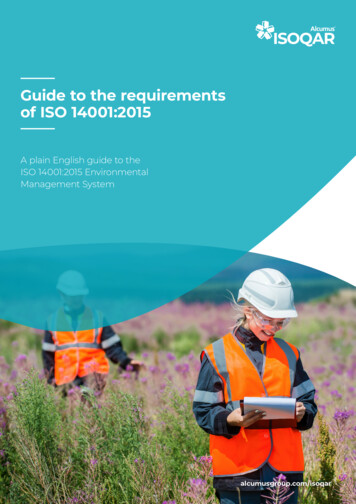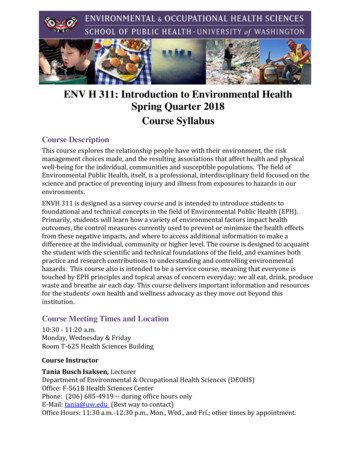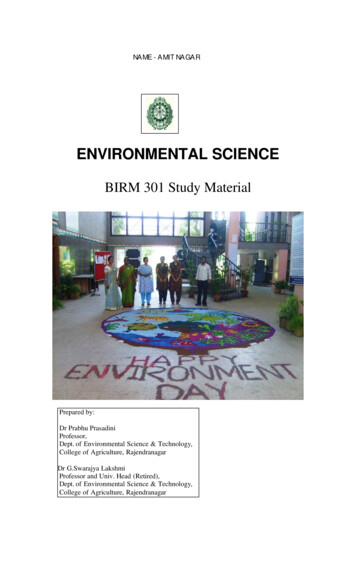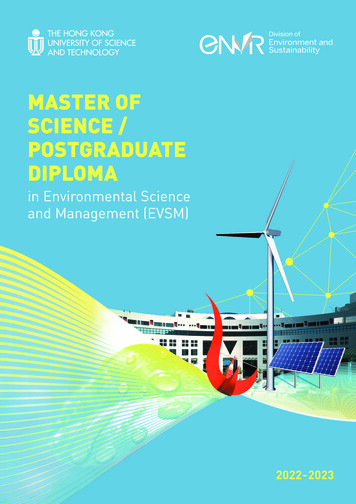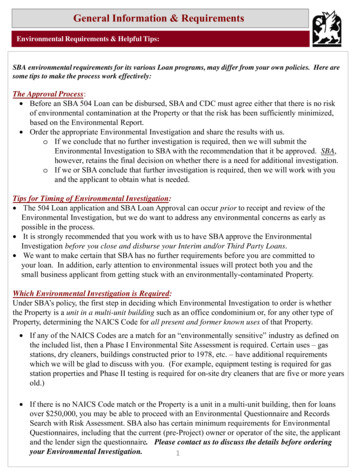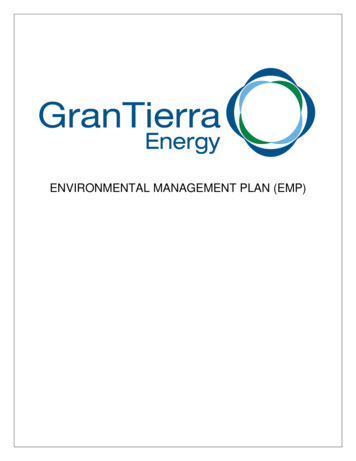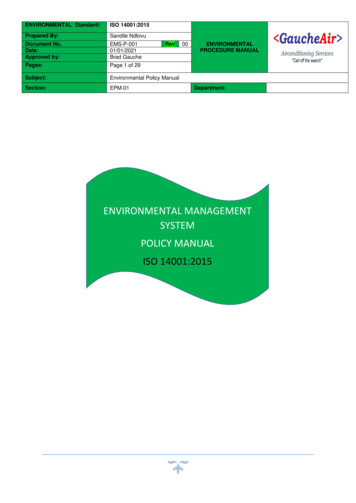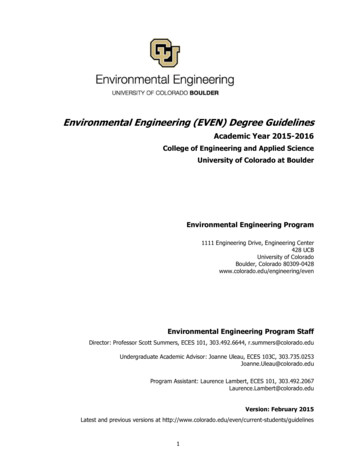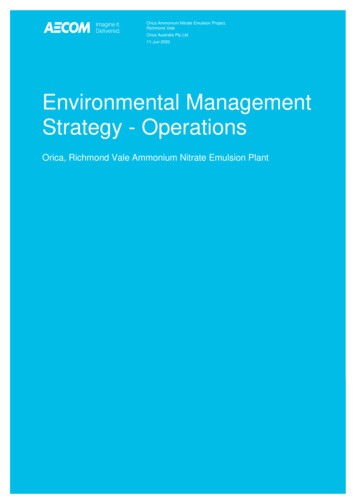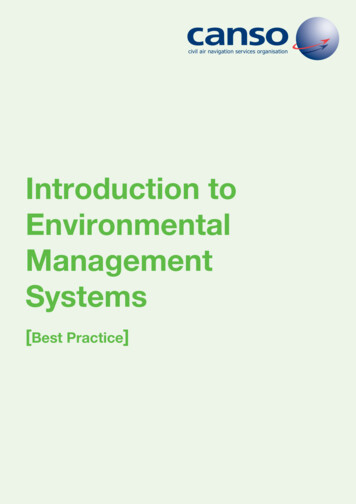
Transcription
civil air navigation services organisationIntroduction toEnvironmentalManagementSystems[Best Practice]
Contents1 Foreword p32 The Benefits of an EMS p43 What is an EMS? p54 What is an EMS used for? p55 Environment Management Systems and theANSP p66 An ANSP Environmental ManagementSystem in Practice – Interview withAirservices Australia p87 Elements of an Environmental ManagementSystem p108 Self Assessment p129 EMS and Collaboration p1310 Conclusion p1311 How can CANSO help? p1312 Glossary p14 CANSO 2012This white paper is for information purposes only.While every effort has been made to ensure the qualityand accuracy of information in this publication,it is made available without any warranty of any kind.www.canso.org
Introduction to EnvironmentalManagement SystemsIntroduction to EnvironmentalManagement Systemsfor Air Navigation Service Providers1ForewordIncreasingly, CANSO is observing a greaterdesire for Air Navigation Service Providers (ANSPs)to implement global systems that assist them tomanage the impact their business and operationshave on the environment.Recognising the need to support ANSPsto manage the environmental expectationsplaced upon them, CANSO has developed thisIntroduction to Environmental ManagementSystems as a preliminary information package forANSPs seeking guidance on what is required toestablish an industry recognised EnvironmentalManagement System (EMS).CANSO acknowledges that many of itsmembers are already advanced in their ability toaccurately manage environmental issues, howeverwe recognise that further information is required ifall members are to create consistent managementpractices. This document is designed to explainthe benefits, the key elements, and best practicewhen seeking to implement an EMS.The information compiled in this documenthas been sourced through questionnaires toCANSO members and developed through wideindustry review and input form the CANSOEnvironment Workgroup.For more information please go to:www.canso.org/environment.2 3
2The Benefits of an EMSAn EMS ensures that an organisation hasidentified, and is managing, its environmental risks ina systematic manner. It facilitates:1.Reduced impact on the environment;2.Sound (effective and efficient)environmental performance;3.Continuous improvement;4.Meeting legal and otherenvironmental obligations; and5.A due diligence approach toenvironmental management for theorganisation and its staff.By adopting a systematic and due diligentapproach to environmental management, ANSPs areable to improve their environmental performance,reduce business risk and demonstrate improvedenvironmental performance to stakeholders.Used in consultation with stakeholdersan EMS can help to focus priorities and avoidwasted effort leading to reduced operational costs.Furthermore, an EMS can secure growth, supportairspace changes, avoid constraints, and helpimprove quality of life for people around airports.Other benefits can stem from the costsavings due to better planning and identification ofdeficiencies, enhancing awareness and skills amongemployees, plus reduced liability and improvedcompliance which in turn leads to an improved publicimage and higher customer trust.Establishing an EMS does need an increasedinvestment in staff time and potentially assistancefrom external consultants. However the long termbenefits should outweigh the costs of implementingan effective EMS.An EMS helps ANSPs effectively: —Identify and assess environmentalissues and risks,—Develop and implement appropriatemanagement for risks (risk treatment,operational control, emergencyplanning, incident reporting andassociated corrective and preventativeactions etc),—Document risk identification,assessment and management so thatdue diligence can be demonstrated,—Reduce the use of resources andprovide a systematic focus on YMANAGE
Introduction to EnvironmentalManagement Systems4 53What is an Environmental Management System?4What is an EMS used for?All organisations have some impact on theenvironment. An EMS is a structured systemdesigned to help an organisation to reduce theseimpacts through targeted continuous improvementin its environmental management, leading toimprovements in its environmental performance,while delivering bottom line benefits throughreduced operating costs.An EMS is the part of an organisation’soverall management system which enables it tomanage its environmental risks, achieve and controlthe expected level of environmental performanceand provide a structured process for achievementof continual improvement. An EMS supportsenvironmental protection, biodiversity conservation,ecologically sustainable development and resourcesustainability.An EMS may be certified, registered orincorporated into existing management systemsand documentation, and can be used to enhancerather than replace existing systems. In manycases much of an EMS can be provided by existingmanagement systems with minimal costs foradjustment.By way of European example, an EMS canbe certified by the ISO 14001 international standardor registered under the EU Eco-Management andAudit Scheme (EMAS 1) statute by an auditor incertification of standard or an approved EMAScontroller.The environmental management system canbe used as an aid to:1http://ec.europa.eu/environment/emas/index en.htm— Identify and reduce the operation’s impacton the environment,— Introduce controlling routines,— Establish tangible environmental goals forimprovement,— Introduce an environmental managementprogramme in order to achieveenvironmental goals,— See that environmental activities arefunctioning,— Continually assess and evaluateenvironmental activities,— Plan, manage and act using informationgained from assessments and evaluations,— Create the basis of reliable communicationsurrounding environmental activities,— Improve negotiation on proposedenvironmental constraints.
5Environment Management Systemsand the ANSPAn EMS is a management tool that can beused by ANSPs to reduce the environmental impactof their operations and improve their environmentalperformance. An EMS can assist an ANSP managethe direct impact of its operations (e.g. assetmanagement such as fuel storage facilities) and boththe direct and indirect impacts of third parties – suchas airlines and airports - that can be affected byANSP decisions and service provisions (e.g. changesto aircraft impacts from airspace changes).ANSPs such as Luftfartsverket in Sweden(www.lfv.se) and Airservices Australia(www.airservicesaustralia.com) are progressivelyimplementing an EMS aligned to internationalstandards such as ISO 14001 as an effectivetool to facilitate the management of CNS/ATMenvironmental issues. However, as highlightedabove, environmental management can also bepart of an overall management system and neednot specifically be implemented separate to othermanagement systems.An organisation that already has, for example,an ISO 9001 Quality Management System, canintegrate an EMS as many common elementsare shared. This also applies for the GreenhouseGas Accounting Standard, ISO 14064 and otherexamples. The new ISO 9004:2009 “Managing forsustained success of an organisation” also refers toenvironmental management.Any EMS can be used, but CANSO believesthat systems should be in line with recommendedinternational standards, and at minimum it shouldassist the ANSP consider the following:— What is being done?— How does this effect the environment?— What is specified in the legislation andregulations?— What improvements can be made?The day to day operational, legislative andregulatory requirements imposed on ANSPs varysignificantly. However an EMS typically incorporatesall elements of an ANSP’s environmental managementimpacts and practices, including:— Aircraft emissions on climate change andlocal air quality;— Aircraft noise on people living near airports;— On-ground facilities and operations (fuelstorage, fire fighting training etc)– pollution,risks to threatened species etc, and— General office operations in terms of energyand resource usage and waste.If the activities that cause these impacts are wellmanaged:Their impact on the environment will beminimised. For example:—Improvements to domestic and internationalair routes, implementation of RVSM (ReducedVertical Separation Minima), User PreferredRoutes and air traffic flow managementtechnology can reduce aircraft fuel burn,resulting in more efficient operations,saving millions of dollars and reducing carbondioxide emissions;—The risk of fuel spill is reduced;—Threatened species are conserved on land;—Energy usage is reduced and as aconsequence greenhouse gas savings can beachieved in buildings;—Reduced resource usage through theimplementation of policies such as the use ofdouble-sided printing and recycling projects.Business risks will be reduced. For example:—There will be less risk of non-compliance withenvironmental legal requirements, which canresult in prosecution, large fines and even jailsentences;—The cost of operations is likely to decrease –with less clean up costs, fines and the timespent trying to fix the problem after ithas occurred;—Being seen to be “doing the right thing” canreduce public concern and make an ANSP’s jobeasier (eg it can make the implementation ofchanges to air routes simpler, reducing the timerequired in public consultation).
Introduction to EnvironmentalManagement Systems6 7Typical Environmental Impacts for an ANSP may include, but are not restricted to:Environmental ImpactsAircraft EmissionsAircraft NoiseOn-ground Facilities& OperationsImpactAircraft emissions contribute toclimate change as they:- emit greenhouse gases(carbon dioxide)- trigger the formation of contrails(water vapour) & cloudformationAircraft emissions also impacton the local air quality.ImpactAircraft noise, particularly atnight, can create strong feelingsamong those living near airportsand under flight paths. Air routestructures and air traffic services (ATS) procedures influencethe location of the aircraft andhence the impact of the noise.ImpactActivities and facilities thatmay create environmental risksinclude, fuel storage; wastedisposal; building maintenanceand construction; resource use– electricity usage, water usage,and land management.ManagementCANSO has estimated that a4% increase in ATM efficiencyis achieveable by 2050 as airtraffic quadruples, deliveringa savings of 79 million tons ofCO2 per year.ManagementManagement programs thatan ANSP has to minimise theimpact of aircraft noise include:ManagementManagement of these risksinclude:Systems and standards thatminimise fuel use include:- User Preferred Routes- Tactical Sequencing- Reduced Vertical- Separation Minima- Constant Descent Approaches- Tailored Arrivals- Automatic DependentSurveillance Broadcast- Compliance with NoiseAbatement Procedures- Noise and Flight PathMonitoring Systems;- Noise Complaints responseservice;- Environmental impactassessment of changes toproposed air traffic servicespractices;- Aircraft Noise Modelling;- Incorporation of environmentalconsiderations in air route,airspace and proceduresdesign eg Noise AbatementProcedures;- Environmental controlsincorporated in workprocedures;- Environmental EmergencyPlans;- Risk assessment of all activitiesthat may impact on theenvironment;- Proposed Risk treatment forall significant environmentalrisks;- Training and Awarenessprograms;- Assigned responsibility;- Environmental assessmentof changes to operations thatmay substantially impact onthe environment;- Auditing implementation ofthe Environmental ManagementSystem and compliance withprocedures.
6An ANSP’s EMS in Practice - Interview withKen Owen, Senior Environmental Specialist,Airservices Australia1.Tell us a bit more about the Airservices EMSAirservices Australia has implementedan ISO 14001-aligned EMS. The EMS is simplya management process that identifies ourenvironmental issues and generates managementprograms to deal with those problems. It alsoensures that any non-compliance is reported andthat we can continuously improve our environmentalperformance.Environmental awareness across the entireorganisation is critical to Airservices Australia’ssuccess in business and as an environmentallyresponsible air navigation service provider. It is ourindividual responsibility to ensure that for our wholebusiness our environmental performance is secondto none. This is not just an environmental objective,but it is also an important business objective.2.When was it implemented, how long did ittake, and how much effort was involved?Airservices Australia began implementingan ISO 14001 aligned EMS in April 1998. Thedevelopment of the EMS to this point had involvedtwo staff members and took about 9 months todevelop. While there were two staff membersdedicated to this project it also involved a numberof people from other areas of the organisatione.g. Aviation rescue and fire fighting (ARFF),facilities management, air traffic control (ATC) andproperty management in workshops to identifyissues and develop a system that would meet theorganisation’s business needs.The development and implementation of theEMS was based on a risk management approach,whereby the organisation identified the highestenvironmental and environmental business risks.As a result the EMS was first implemented tomanage changes to ATC practices and proceduresincluding airspace and flight path changes whereaircraft noise was the major concern. Existing onground activities such as ARFF training facilities,fuel storage, hazardous material management,etc were then addressed. The third stage was thedevelopment of the EMS to address changes toon-ground facilities and activities which addressesactivities such as new surveillance and navigationfacilities, fire stations etc.In 2004 Airservices had its first site,Gellibrand Hill Radar near Melbourne Airport,certified to ISO14001. A second site, our ARFF,navigation aid sites and facilities management atGold Coast Airport was also certified to ISO14001in 2007.3.How is the EMS implemented andmonitored?Airservices’ EMS applies to the organisation’soperations nationally (some 1,000 sites at 600different locations). It is centrally managed butimplemented locally. This has required extensivetraining of staff during the implementation of theEMS. Ongoing training is essential to ensure thesystem continues to be used effectively. Thishas been a challenge both due to the number ofstaff that require training and the geographicallydispersed nature of Airservices operations. Tofacilitate the effective implementation of theEMS, Airservices developed a bespoke computerapplication, called Airservices Risk ManagementSystem (ARMS). The ARMS risk managementtool provides risk identification and assessment;current risk controls; proposed risk treatmentincluding objectives & targets; emergency plans andincidents reporting functions; and non-conformancereporting. In this way ARMS assists the EMS tocomply with the requirements of both relevantlegislation and the ISO 140001 standard.
Introduction to EnvironmentalManagement Systems4.What challenges has your organisationfaced?The biggest challenge faced has been thetraining of staff and changing the culture of theorganisation. A priority for effective EMS is to developan environmentally sustainable culture (like ANSPshave had in safety for many years). An EMS does notwork without visible top management commitmentsupporting a business culture that is led from thetop.5.What benefits have accrued, either withstaff, politicians, or direct financial benefit?The single leading benefit has been theidentification of legal and regulatory obligations theorganisation needs to comply with and to assurethat these are being complied with. The ISO14001certification also allowed Airservices Australia tocomply with a Government direction that requiredall agencies and departments to implement anISO14001 certification of at least one site.6.In your view has the EMS helpedAirservices achieve continuous improvement inreducing environmental impact?The EMS has allowed Airservices to identifythe environmental aspects of its activities todetermine those that have significant impactsand potential liabilities as well as identifying alllegislative and regulatory requirements. Therequirements for continuous improvement allowAirservices Australia to ensure that the EMSremains relevant to the organisation, review theeffectiveness of the system, determine the extentto which environmental objectives and targets havebeen met, and identify required change to reflectconcerns of interested parties such as regulators,government, customers and communities.8 9
7Elements of an EnvironmentalManagement SystemThe primary purpose of an EMS is todetermine which aspects of the business have animpact on the environment. Once identified, thesecomponents are systematically managed to achievebetter control and performance.The EMS cycle can be thought of as a Plan,Do, Check, Act process of continuous improvement,aimed at improving business and VEMENTCheckingEnvironmental PolicyAn organisation’s environmental policy is themost important steering document and describesthe elements of an organisation’s environmentalactivities. It defines the ambitions and visionsrelating to these activities and should ensure thatthey are thoroughly adopted by the organisation’smanagement group.The contents of the environmental policyshould be in accordance with an ANSP’s significantactivities and services that can impact with theenvironment, and also include a commitmentto continually improve environmental activities,prevent contamination and not least incorporateenvironmental legislation and other relevantrequirements.All staff within the ANSP should be awareof the contents of the environmental policy; thisincludes those working as consultants to theorganisation.Implementation& OperationEnvironmental ReviewAn initial environmental review is required toidentify all the organisation’s environmental aspectsand impacts. The review should cover four keyareas:—Identification of activities or services thatcan interact with the environment,—Identification of legislation and otherrequirements which affect the organisation,—Assessment of the organisation’senvironmental methods and routines,including procurementand hiring of consultants, and—Evaluation of experiences from previousincidents.PlanningPlanning should identify the legislation whichapplies to the organisation and which will affectits operations/activities and services from anenvironmental perspective. The environmentalimpacts identified in the initial review stage alsoneed to be identified in this process. To obtain theobjectives and targets set, necessary actions needto be planned.Consultation with all stakeholders andinterested parties is a necessity at the planningstage to confirm ANSP policy priorities; to identifythe actions, deliverables, milestones, timeline andKPIs required to ensure progress towards specificobjectives and targets; to allocate responsibilities;and to plan for reporting mechanisms andpromulgation activities.Implementation and OperationHaving conducted extensive planning activitiesall that remains is the actual implementation. Theimplementation and operation should describe how theoperation is governed in order to achieve environmentalobjectives as well as reduce environmental impact ofthe more important environmental aspects.
Introduction to EnvironmentalManagement SystemsThe management should at this stage makeavailable adequate resources for the functioningof the environmental management system.Implementation and management involvesroles, authorities and defining responsibility,documentation and communication.The organisation should also see that routinesare established and maintained for areas such asemployee training courses, and internal and externalenvironmental organisational communication.Emergency preparedness is necessary to preventand reduce any possible environmental impact dueto incidents.CheckingChecking involves identifying and handlingdeviations or improvement activities. There area few different ways for organisations to dothis. Subsequent actions include measuring,monitoring, and evaluating so-called environmentalperformances. Environmental performance is ameans of expressing a company’s environmentalaspects in the form of ratios.An environmental audit involves a systematic,recorded, objective and periodical evaluation of anorganisation’s EMS, environmental organisationand routines as well as equipment. An organisationnormally uses external as well as internal audits.The aim of conducting checks is to verify ifthe environmental management system is fullyfunctioning to the requirements specified by themanagement.Management ReviewDuring the management review, the wholeof the organisation’s EMS should be discussed.Management should review the system to check itssuitability, adequacy, objectivity and efficiency. It isnot necessary to cover all parts of the environmentalmanagement system at the same time but all shouldbe covered within a certain time period, for exampleduring a calendar year.The results from both the internal andexternal audits, records, measurements, deviationsand management plan are an aid to briefingmanagement and assisting decision-making.Management reviews should include all10 11possible needs relating to changes in environmentalpolicy, comprehensive environmental objectives,following up of legislation and other parts of theenvironmental management system based on, forexample, results of the revision.Accounting documents presented by themanagement should contain agendas, list ofparticipants, notes relating to subject matter anddecisions, reports and minutes. In this way thewhole process begins again as the demand forcontinual improvement should be achieved.
8Self AssessmentAs previously mentioned, a typical ANSP mayalready have elements of an EMS embedded in itsoverall management system. Before investing in anEMS, a simple self assessment of existing systemsand practices provides an organisation with aclear picture about what already exists and whereimprovement is required.Level1. BasicAssessment ElementsEnvironmentalaspects areidentifiedBasic environmentalcontrols are in place2. Proactive(Basic )A policy describingthe organisation’senvironmentalambitions isdefinedThe contents of theenvironmental policyare inaccordance with theANSP’s significantenvironmentalimpacts Containsa commitment tocontinually improveenvironmentalactivities and reduceenvironmentalimpactsEnvironmentallegislation and otherrequirements whichapply to theorganisation andwhich can affect itsoperations / activitiesand services from anenvironmentalperspective areidentified3. Flexible(Proactive )Processes areimplemented toachieve environmentalobjectives as well asreduceenvironmentalimpact of the moreimportant businessactivitiesManagement hasmade availableadequate resourcesfor the functioning ofthe environmentalmanagementsystemRoles, authoritiesand responsibility,documentation andenvironmentalcommunication aredefinedAll staff withinthe ANSP areaware of thecontents of theenvironmentalpolicyMeasuring andmonitoring is inplace andenvironmentalperformance isevaluatedEnvironmentalaudits areperformed andevaluated in asystematic,recorded,objective mannerAt pre-determinedintervals, themanagementchecks the system’ssuitability, adequacy,objectivity andefficiencyThe organisation isprepared foremergencies toprevent and reduceany possibleenvironmental impactdue to incidentsThe organisation hasa process of continualimprovement in placeto take into accountthe need forenvironmentalprotection in the totallife cycle of itsservicesThe environmentalpolicy isaccessibleby the general public4. Progressive(Flexible )5. AchievingSustainedSuccess(Progressive )2There are five levels2 of environmentalachievement against which an organisation shouldassess itself.By undertaking a basic assessment suchas the one outlined below, an organisation candetermine the maturity of its existing system,and use the information to improve or modifyits performance and appropriately apportioninvestment.The organisation can demonstratethat its approach to environmentmanagement meets the needs ofthe present, without compromisingthe needs of future generations ofsocietyAs determined through CANSO Member consultation and by the CASNO Environment work group
Introduction to EnvironmentalManagement Systems12 139EMS and Collaboration10ConclusionThe basic formation of an EMS is likely to bedriven (at least in part) by imperatives for externalbodies such as airspace users, airport operatorsand regulators.An EMS developed in collaborationwith others in the aviation community will bemore efficient and productive. In its documentCollaborative Environment Management (CEM)EUROCONTROL emphasises the importanceof a collaborative approach to environmentalmanagement around airports.CEM is an effective tool for implementing aprocess that allows partnership between aviationstakeholders (airport and aircraft operators) inorder to address environmental measures coveredin this document.EUROCONTROL points out that CEM is notan alternative to individual stakeholder EMS butit is augmented by these and complements them.All stakeholders need to be encouraged to modifyindividual management processes (e.g. EMS) tosupport CEM.3This document has been designed togive ANSPs an introduction to environmentalmanagement systems. It has looked at explainingwhat an EMS is, the benefits to ANSPs ofimplementing an EMS, and the key elementsan effective EMS should contain. Some furtherinformation, including the Airservices Australiaexperience in creating and implementing an EMS,has been included to give ANSPs an insight into thechallenges and benefits of proceeding with an EMS.It is the experience of those ANSPs whohave already implemented an EMS that suchsystems lead to an improvement in environmentalperformance as well as save resources and improveefficiency. ANSPs can also benefit significantly fromimplementing an environmental management systemas it can be used to support and improve othermanagement systems used across the business.Overall, ANSPs strengthen their business bycreating greater control and knowledge over theirown activities. The creation and implementationof an EMS is an important stage in an ANSP’sorganisational maturity, and plays a role in helpingthe entire ATM system raise its environmentalperformance, for the benefit of all.11How can CANSO help?It is the aim of CANSO to support ANSPs in their efforts to raise the individual and collectiveperformance of the ATM system. The CANSO Environment Workgroup is committed to improvingATM operational and environmental performance through the delivery of guidance material andbenchmarking metrics, and the spread of best practice throughout the industry. CANSO also providesa global forum for the ATM industry to debate and agree global solutions to key issues and toestablish industry goals.The CANSO Environment Workgroup will continue to explore ways to assist ANSPs manageenvironmental performance. For more documents, visit our website www.canso.org/environment3Source: tent/public/documents/CEM final 17%2011%2008.pdf
12 Glossary of Environmental Management Terms12GlossaryActivityA specific area of theoperation. For example:decisions relating toheating of buildings,vehicle maintenanceetc.Controlling DocumentsThose documents thatstate how an actionor process should becarried out or checked.Control of RecordsDocuments thatdemonstrate theresult of work andchecks carried out etc.Management journalsand analyses minutesare examples ofrecords.Dangerous WasteMatter, materials, rawproducts, chemicals orother surplus productswhich, accordingto the law, containsuch substances orchemicals which aredangerous to healthor the environment.Included in dangerouswaste are also objects,tools, equipmentor other materialswhich contain or havebeen polluted bysuch substances orchemicals which aredangerous to health orthe environment.Direct or IndirectEnvironmental ImpactDirect environmentalimpact refers to thosesituations that occurthrough an ANSP’sown operations.Indirect refers to theenvironmental impactthat occurs throughthe activities of othercompanies, such as theaffect on an airport byairlines.EnvironmentSurroundings inwhich an organisationoperates, including air,water, land, naturalresources, flora, fauna,humans and theirinterrelation.Environmental AspectsThose parts ofan organisation’sactivities, operations,products, or serviceswhich can impacton the environment.Comprises direct andindirect environmentalaspects. Aspectscan arise during bothnormal and abnormalconditions.Environmental AuditA systematic,documentedverification processto assess whetherthe environmentalmanagement systemis in accordance withcontrol criteria.Environmental ImpactAll changes in theenvironment, eithernegative or positive,which are wholly orpartly the result ofthe organisation’sactivities, productsor services. Forexample pollution ofland, contributing togreenhouse gases etc.EnvironmentalManagementSystem(EMS)This tool is usedto ensure that allenvironmentalactivities are carriedout systematically,are aimed at continualimprovements and alsoprovide managementwith control over itsdevelopment.EnvironmentalPerformanceMeasurable resultsfrom the environmentalmanagement system.Environmental PolicyEnvironmentalactivities, intentionsand principles held bythe organisation.ISO 14001:2004The InternationalStandardOrganisation’sinternational standardfor EnvironmentalManagement Systems.Legal and OtherRequirementsMake sure thatapplicable laws andother requirementsare identified andaccessible. Distinguishthose that might havea significant impact o
identified, and is managing, its environmental risks in a systematic manner. It facilitates: 1. Reduced impact on the environment; 2. Sound (effective and efficient) environmental performance; 3. Continuous improvement; 4. Meeting legal and other environmental obligations; and 5. A due diligence approach to environmental management for the

